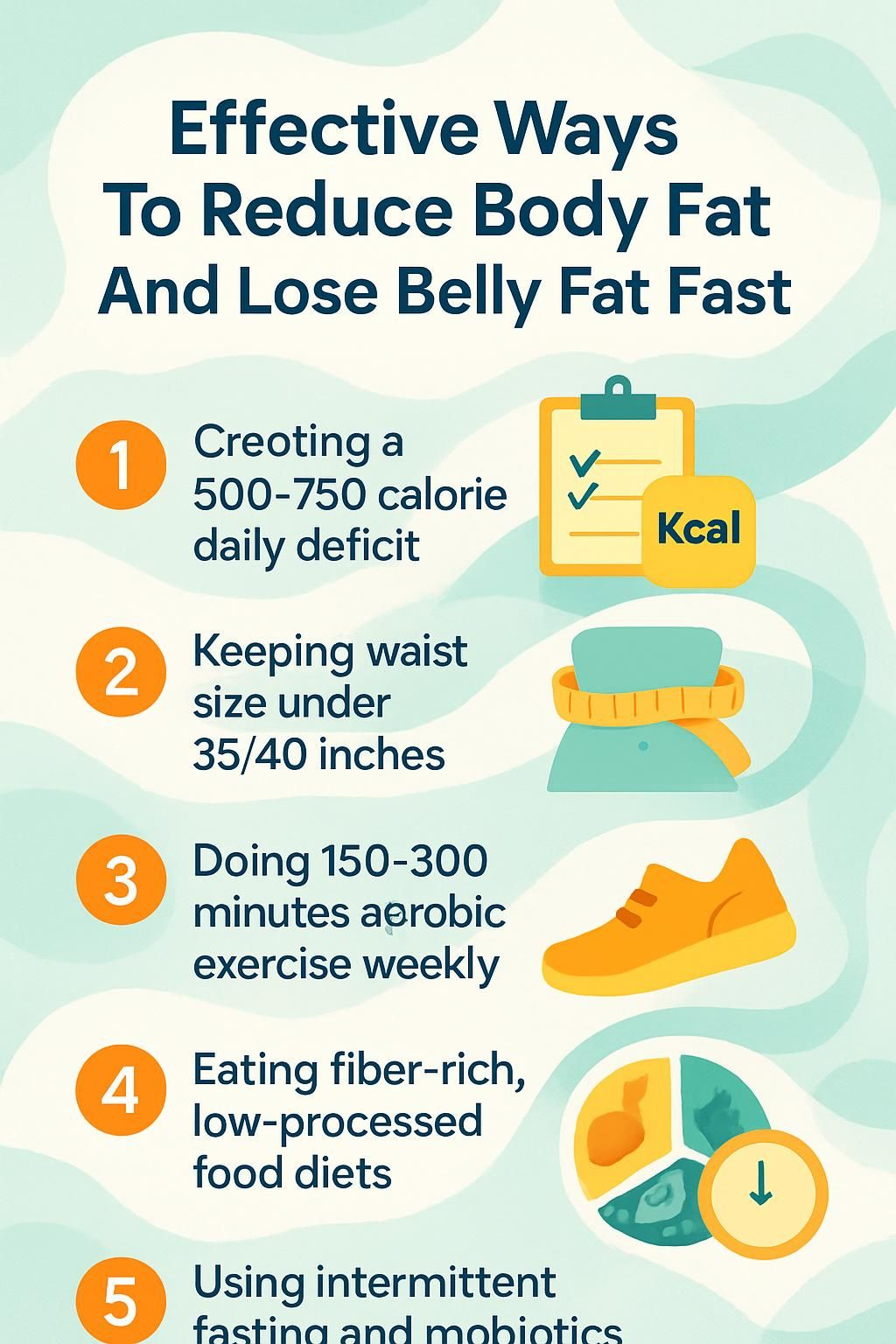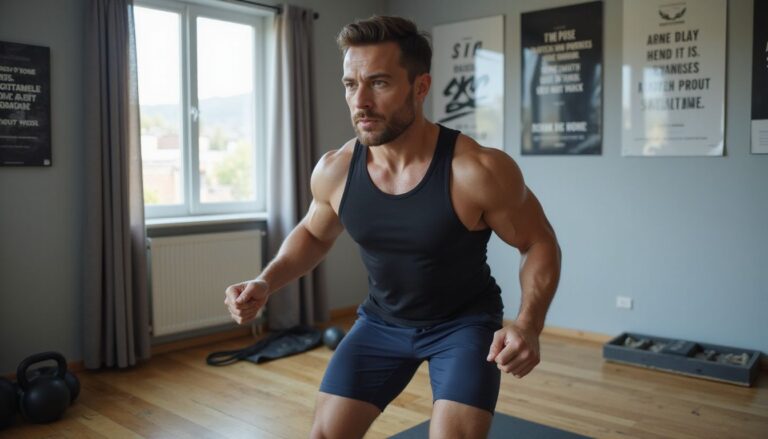Effective Ways To Reduce Body Fat And Lose Belly Fat Fast
Our Nutrition Assistant AI Suite will transform your body. You will lose fat, get toned, and build muscle. Gain confidence and optimal health.
Losing body fat, especially belly fat, can feel confusing at first. The good news is that simple, steady habits work. Research links a healthy waistline with longer life and lower risk of heart disease and diabetes.
In this guide, you will learn clear steps that fit real life. You will see how smart food choices, regular physical activity, and small daily changes create results you can measure.
Key Takeaways
- Creating a daily calorie deficit of 500–750 calories, tracked using apps like MyFitnessPal, can help you lose 1–2 pounds per week according to Johns Hopkins research.
- Reducing visceral fat by keeping waist size under 35 inches for women and 40 inches for men lowers risks of heart disease, type 2 diabetes, and early death.
- Combining aerobic exercise, 150–300 minutes weekly, strength training twice per week, and HIIT, as supported by 2022 and 2023 studies, accelerates fat and waist reduction.
- Diets high in fiber from whole grains, fruits, and vegetables and low in sugary drinks or processed foods, as recommended in 2021 reviews, support long-term fat loss.
- Intermittent fasting and probiotic intake, supported by 2024 studies, can further reduce waist circumference and visceral fat, but consistent habits matter most.

Types of Body Fat You Should Know

Your body stores fat in more than one way, and each type affects health differently. Knowing what you carry helps you choose the most effective ways to lose body fat and keep it off.
What is Subcutaneous Fat and How Does It Affect You?
Subcutaneous fat is the layer under your skin. It is the fat you can pinch with your fingers or measure with skinfold tools during a body composition test.
This fat differs from visceral fat, which sits deeper in the belly around organs. Subcutaneous fat is less risky for disease, but too much can affect how your clothes fit and how you feel in your body.
Large amounts may signal overweight status even if health risks are not as high as with visceral fat. After I shifted to more whole grains, fruits, and vegetables, I noticed less under-the-skin fat and felt more comfortable in daily movement.
Subcutaneous fat also stores energy and helps keep you warm, which is normal and useful in healthy amounts.
Why Is Visceral Fat More Dangerous?
Visceral fat surrounds your organs, such as the liver and pancreas, inside the abdomen. This type raises the risk of type 2 diabetes, heart disease, and some cancers.
High visceral fat often drives higher insulin levels, which can make fat burning harder and fat storage easier. Doctors often suggest tracking waist size because it reflects internal fat better than scale weight alone.
Aim for a waist under 35 inches for women and under 40 inches for men. Even with a normal body mass index, hidden visceral fat can raise risk. I learned this first-hand when my waist measurement changed before the number on the scale moved. That simple tape measure helped me make better choices.
Knowing your numbers makes it easier to act early and protect long-term health.
Why Is Reducing Body Fat Important?
Reducing body fat lowers your risk of disease and type 2 diabetes. It also supports a healthy weight, more energy, and a better quality of life.
What Are the Health Benefits of Losing Fat?
Losing fat lowers the risk of heart disease, type 2 diabetes, and metabolic syndrome, a group of risk factors that raise the chance of illness. Dropping just 5 percent of your body weight can improve blood vessel function and reduce belly obesity.
Research from Johns Hopkins in 2012 found that both low-fat and low-carb plans improved artery health following weight loss. Many people also report better sleep and steadier energy as weight drops.
Healthier arteries and a stronger circulatory system often follow fat loss. I noticed easier breathing and steadier energy after a period of steady weight loss. The American Heart Association notes that less abdominal fat can improve blood pressure and cholesterol.
A small reduction in body weight can produce meaningful health benefits long term, says Dr. Kerry Stewart of Johns Hopkins.
How Does Fat Loss Impact Longevity?
Reducing body fat does more than change how you look. Lower fat, especially around your waist, links to longer life and fewer serious health events.
People who keep a healthy waist–hip ratio tend to have lower risk of cardiovascular disease, diabetes, some cancers, and early death. Cutting visceral fat in particular can reduce the chance of heart attack and stroke.
Steady changes in diet and activity create results that last. I swapped refined grains like white bread for whole grains and added regular aerobic exercise. Over time, my energy rose and my risk profile improved.
Keeping a healthy body fat percentage supports a longer life and more active years.
Calorie Deficit: The Key to Losing Fat
A calorie deficit means you eat fewer calories than your body uses. Creating this gap is the foundation of fat loss, and it works for the long term.
How Do You Consume Fewer Calories Than You Burn?
To lose 1–2 pounds per week, research suggests a 500–750 calorie daily deficit. Simple steps help you get there and stay there.
- Track what you eat with an app or a food diary. People who track intake lose more weight and keep it off longer.
- Choose whole foods like fruits, vegetables, whole grains, and lean proteins. These foods keep you full and reduce cravings for processed snacks.
- Trim portion sizes. Small cuts at each meal add up to real progress.
- Limit added sugar and sweetened drinks. Liquid calories climb quickly without helping fullness.
- Swap high-calorie snacks for fiber-rich options such as nuts or oats. Fiber helps digestion and controls hunger.
- Cook with lower calorie methods like grilling, steaming, or baking instead of frying. You keep flavor without extra oil.
- Drink water before meals. It can help you feel full with zero added calories.
- Move more during the day. Walking and strength training increase how many calories you burn.
After logging everything I ate for two weeks, I found hidden calories in sauces and snacks. Honest tracking changed my choices fast.
What Are the Best Ways to Track Your Calorie Intake?
Good tracking keeps your plan accurate. Use tools that fit your life and privacy needs.
- Use a digital food journal such as MyFitnessPal or Lose It!. These apps include large food databases, which makes logging easier.
- Read labels on packaged foods, including condiments. In the United States, labels list calories, carbohydrate, protein, and fat per serving.
- Weigh and measure portions with a kitchen scale and cups. Estimating often leads to undercounting.
- Keep a written journal if you prefer less screen time. Writing what you eat boosts honesty and consistency.
- Photograph your meals. Photos help you spot calorie patterns, such as large portions or sugary drinks.
- Review logs each day or week. Adjust choices to increase protein or fiber and protect muscle mass.
- Note how your clothes fit along with your entries. Real-life feedback confirms what the numbers show.
For me, a food journal kept portions in check and cut extra snacks. That simple habit moved the needle on body composition.
How Should You Modify Your Diet to Lose Fat?
Targeted diet changes reduce fat mass and visceral fat. Simple swaps can help you lose weight and keep it off.
Why Increase Fruits, Vegetables, and Whole Grains?
High-fiber foods keep you full on fewer calories. Aim for at least four servings of vegetables and three servings of fruit per day.
A 2021 review found that people who eat more whole grains weigh less and carry less belly fat than those who rely on refined grains. Whole grains like barley and bran digest more slowly and limit sharp spikes in glucose, the sugar in your blood.
Fruits and vegetables add volume without many calories. Many experts suggest filling half your plate with produce.
Swapping chips for sliced pears curbed my drink cravings during a tough phase of dieting. Fiber supports metabolism, helps protect your arteries, and steadies hormones while you lose fat without losing muscle.
What Foods Should You Avoid Like Sugary Drinks and Processed Items?
While whole foods make sticking to a calorie deficit easier, some items work against progress. Skip sodas and other sugary drinks. A 2023 review of 85 studies links them to higher weight and BMI.
Processed foods, such as packaged snacks and frozen meals, often contain trans fats, added sugars, and excess salt. These ingredients increase calorie intake and can add body fat around the organs.
Alcohol adds calories quickly and is tied to more belly fat. Bread and bagels are dense in carbs, so large portions can lead to weight gain. Low-fat yogurt may look healthy, but many brands add sugar.
I switched from soda to water and noticed better energy and fewer cravings in one week. Careful label reading helped me spot sneaky sugars.
How to Incorporate Healthy Fats and Lean Proteins Effectively?
Add healthy fats like olive oil, avocados, nuts, seeds, and fish such as salmon. Use small amounts for flavor, since fat is calorie dense.
Include lean proteins to maintain skeletal muscle during weight loss. Most people do well with 10 to 35 percent of their daily calories from protein. On a 2,000 calorie plan, that is about 50 to 175 grams.
Good options include skinless poultry, fish, eggs, low-fat dairy, beans, and tofu. Try grilled chicken at lunch, Greek yogurt at breakfast, or beans in salads.
This approach helps protect fat-free mass and supports a steady metabolism while you run a calorie deficit.
What Exercises Help Reduce Fat Effectively?
Exercise helps burn calories and reduce both under-the-skin fat and deeper belly fat. Think of movement as your daily spark for change.
How Does Aerobic Exercise Like Running or Swimming Help?
Running, swimming, cycling, and brisk walking are aerobic exercises. A 2022 review of 15 studies found these activities reduce waist size.
The U.S. Department of Health and Human Services suggests 150 to 300 minutes of moderate activity or at least 75 minutes of vigorous activity each week. Cardio improves heart and lung function and burns calories during and after workouts.
Regular aerobic sessions can lower insulin levels and target intra-abdominal fat. I found swimming reduced my hunger after workouts, which made it easier to follow a Mediterranean-style plan. Over time, running plus that diet helped me drop 10 pounds and trim my waist.
These habits also support healthy blood vessels and reduce risk tied to overweight and obesity.
Why Is Strength Training Important for Fat Loss?
Strength training protects lean muscle while you lose fat. If you avoid resistance work or eat very few calories, muscle loss can follow.
Exercises like push-ups and weight lifting keep muscle on your frame. More muscle raises your daily calorie burn, even at rest.
A 2021 review of 58 studies found that four weeks of resistance training reduced body fat by an average of 1.46 percent. Guidelines recommend at least two strength sessions per week, along with aerobic exercise, for the best results.
When I added push-ups and dumbbells, fat loss sped up and my waist shrank faster.
What Are the Benefits of High-Intensity Interval Training (HIIT)?
High-Intensity Interval Training alternates short all-out efforts with brief rest periods. A 2023 review of 36 trials showed HIIT improves body composition and reduces body fat effectively.
Cycling-based HIIT works well and fits busy schedules. Beginners can mix brisk walking with short jogs or pair bodyweight moves with rest.
I started with 20 seconds of hard pedaling and 40 seconds easy, repeating for several rounds. Within weeks, my stamina and muscle tone improved.
HIIT burns many calories in less time and helps create a calorie deficit. It is an efficient way to target belly fat as part of total fat loss.
How Can Lifestyle Changes Boost Fat Loss?
Daily habits shape your results. Small wins with sleep, stress, and hydration can amplify your progress.
Why Is Getting 7-9 Hours of Sleep Crucial?
Adults need at least 7 hours of sleep each night, according to the CDC. Getting 7–9 hours supports fat loss and energy. A 2023 review linked less than 6 hours of sleep with higher visceral fat.
Too little sleep raises hunger hormones, which can drive cravings for sweets and snacks. That shift makes it hard to maintain a calorie deficit and can slow results.
Many people notice junk food cravings after poor sleep. Prioritizing rest steadies appetite and supports exercise the next day.
What Stress Management Techniques Work Best?
Chronic stress increases cortisol, a hormone that can promote fat storage. Managing stress supports fat loss and better health.
- Practice yoga. Gentle movement and breathing help calm the mind and may reduce belly fat linked to cortisol.
- Meditate for a few minutes daily. A 2020 study found regular meditation lowered BMI in participants.
- Spend time outdoors. Walking in green spaces reduces mental fatigue and supports healthy routines.
- Hydrate with water instead of sugary drinks. This lightens the load on your body and trims calories.
- Keep a regular sleep schedule. Poor sleep raises cortisol and appetite, which undermines weight management.
- Ask a healthcare professional for help if stress feels heavy. A dietitian or therapist can provide tailored strategies.
- Use slow breathing, such as exhaling for twice as long as you inhale. This helps calm your nervous system.
- Lean on supportive friends and family. Strong social ties help reduce stress hormones.
Effective stress control sets the stage for consistent eating habits and steady workouts.
How Much Water Should You Drink to Stay Hydrated?
Proper hydration supports fat loss and appetite control. A common goal is about 8 cups, or 64 ounces, daily. Needs vary with age, activity, climate, and supplements.
If you exercise often or live in a hot area, you may need more. Replace sugary drinks with water, unsweetened tea, or sparkling water with citrus or mint.
Carrying a refillable bottle helped me meet my target during busy workdays. Small hydration habits often lead to steady progress.
Advanced Methods to Lose Belly Fat Quickly
Some strategies can speed results if used with a sound routine. These methods help target stubborn belly fat while protecting health.
What Is Intermittent Fasting and Does It Work?
Intermittent fasting cycles eating and fasting windows. A common approach is 16/8, eating within 8 hours and fasting for 16.
A 2024 review found intermittent fasting lowered body fat, total weight, waist size, and visceral fat. These benefits depend on consistency and an appropriate calorie intake.
Pick a method that fits your life and training. While marathon training, I tried fasting and felt my energy drop, so I worked with a dietitian to adjust calories and timing.
Steady habits matter more than trends. Choose an approach you can maintain.
How Do Probiotics Help With Belly Fat?
Probiotics are helpful bacteria that support gut health. A 2024 study suggests Bifidobacterium strains may reduce body fat and waist size, even if BMI does not change much.
Foods like kefir, tempeh, kimchi, and sauerkraut contain probiotics. Adding a daily kefir smoothie made this habit easy for me.
Probiotics support a healthy gut, which can help shrink your waist over time.
Why Choose Whole Grains Over Refined Grains?
Whole grains contain fiber and nutrients that aid fat loss. A 2021 review shows they support weight control better than refined grains.
Refined grains such as white bread and pastries have a high glycemic index, meaning they spike blood sugar quickly. Those spikes can raise hunger and belly fat.
Swap white bread for whole wheat. Choose oats over sugary pastries. Quinoa and barley offer more vitamins and minerals than processed options.
I replaced my usual sandwich roll with whole wheat and felt full longer after lunch. Pair whole grains with protein, such as beans or tofu, to steady energy and digestion.
Can Supplements Help With Fat Loss?
Supplements can support your plan, but they do not replace a healthy diet and exercise. Learn how they work before you add them.
How Does Whey Protein Support Muscle Preservation?
Whey protein helps you keep lean muscle while losing fat. Higher protein intake supports muscle during a calorie deficit.
In 2020, a study in Nutrients found that people who used whey while dieting maintained more muscle than those who did not. Protein also increases fullness and slightly raises calorie burn due to the energy cost of digestion.
I used a whey shake at breakfast while cutting calories. My strength held steady while weight dropped.
What Performance Benefits Does Creatine Provide?
Creatine boosts performance during resistance training by helping muscles restore energy quickly. People who take creatine often gain more strength and lean mass.
A 2022 study reported 8 percent more lean mass over 12 weeks in creatine users compared with non-users. Better muscle output means you can lift heavier or do more reps before fatigue.
If muscle loss is slowing your progress, creatine may help you keep or add muscle while you lose fat.
When Should You Consult a Healthcare Professional About Supplements?
Speak with a healthcare professional before starting supplements, especially if you have medical conditions or take medications. Some products interact with medicines or affect blood pressure, liver function, or kidney health.
I once tried a popular fat burner without checking and had side effects due to an ingredient that clashed with my medication. A registered dietitian can help you choose safe options that match your goals.
If you plan major nutrition changes, get guidance from a dietitian or a clinician. Many products promise fast results without solid evidence.
What Common Mistakes Should You Avoid When Trying to Lose Fat?
Some missteps slow progress. Avoid these common traps to protect your health and results.
Why Is Over-Reliance on Fad Diets Harmful?
Fad diets promise fast change, but the results rarely last. Cutting whole food groups or severe calorie limits may cause quick water loss and rebound gain.
A 2021 JAMA study found most people regain lost weight within a year on restrictive plans. These diets can disrupt hormones, hurt metabolism, and increase cravings.
I once tried a very low-carb trend to drop belly fat fast and felt tired and irritable. Switching to balanced eating and regular activity helped me lose body fat and feel better.
Sustainable progress comes from steady habits, not extreme rules.
What Happens If You Skip Meals?
Skipping meals often backfires. It can slow your metabolism and increase the urge to overeat later, which makes belly fat harder to lose.
Irregular eating patterns raise the odds of grabbing sweets and high-calorie snacks. Skipping breakfast can lead to poor focus and stronger hunger at lunch or dinner.
Research in the American Journal of Clinical Nutrition showed meal skippers tend to eat more sugary snacks later. Aim for regular meals with fruits, whole grains, healthy fats, and lean protein.
How Important Is Consistency in Fat Loss?
Consistency is the engine of fat loss. People who follow daily habits, like tracking intake and moving their bodies, lose more and keep it off longer.
Real change usually takes weeks or months. Setbacks will come. Keep going and resume your plan at the next meal or workout. Tracking small wins helped me stay focused on goals during tough weeks.
How Do You Track Your Fat Loss Progress?
Use simple methods to see real changes. These trackers keep you motivated when the scale is slow to move.
Why Use Body Measurements Instead of Only the Scale?
Scale weight can bounce day to day due to water, muscle, and digestion. Body measurements show where you are losing fat and building muscle.
Waist size is a strong marker. Aim for under 35 inches for women and under 40 inches for men. Experts link these targets to lower disease risk.
As you improve your diet and exercise, muscle can rise while fat falls. The scale might stall, but inches lost at the waist or hips prove progress. Many people feel encouraged when their clothes fit better even if weight does not change much.
How Can Monitoring Clothes Fit Help Track Progress?
Clothing feedback is simple and honest. Looser waistbands, less tight shirts, or pants that no longer squeeze the hips are strong signs of fat loss even without a drop on the scale.
Body composition shifts with training and diet. You might notice a better fit at the midsection before a change in weight. This real-world measure can keep you motivated.
…
^1 Harvard Health Publishing (2022). “Why do I lose inches but not weight?”
How Do You Maintain Fat Loss Long-Term?
Keeping body fat off requires daily habits that fit your life. Plan for maintenance the same way you plan for weight loss.
What Habits Help Sustain Fat Loss?
Strong habits protect results. Use this checklist to stay on track.
- Track food intake with an app or journal to keep awareness high.
- Make regular physical activity a priority. Aim for 150 minutes of moderate or 75 minutes of vigorous exercise each week, per CDC guidance.
- Eat mostly whole foods, including vegetables, fruits, lean proteins, and whole grains. Limit processed foods and added sugar.
- Plan meals and snacks in advance. Meal prep reduces impulse eating.
- Build a support circle. People with health-focused friends sustain better habits.
- Sleep 7 to 9 hours nightly. Better sleep supports appetite control and energy.
- Manage stress with walking, meditation, or creative hobbies to reduce overeating.
- Drink enough water, about 8 cups daily or more if you exercise.
- Check progress with waist, hip, and other measurements every two to four weeks. Do not rely only on the scale.
How Can You Prevent Weight Regain?
Use a sustainable eating plan and schedule exercise like any important appointment. People who monitor habits and adjust early tend to maintain better.
Keep healthy foods at home and shop with a list. Track meals, activity, and clothing fit. If old patterns return, act quickly. For example, if late-night snacking creeps in, switch to fruit or yogurt instead of processed options.
According to research from the National Weight Control Registry, individuals who keep off at least 30 pounds for one year often share these habits: eating breakfast daily, weighing themselves weekly, limiting screen time, and staying active most days.[1] These strategies support lasting success and daily wellness.
Next, see how professional support can further improve your results.
…
[1] National Weight Control Registry, nwcr.ws/Research/default.htm
When Should You Seek Professional Support?
If progress stalls or feels confusing, expert support can save time and reduce frustration. Personalized guidance makes a big difference.
How Can a Registered Dietitian Help You?
A registered dietitian can tailor a nutrition plan to your goals and medical needs. They consider your lifestyle, health history, and food preferences to build a plan you can follow.
For conditions like diabetes or food allergies, a dietitian ensures your plan is safe and balanced while controlling calories. The Academy of Nutrition and Dietetics reports that working with dietitians improves long-term maintenance.
Expect education, support, and accountability that help you stay consistent. Next, learn how a personal trainer can shape your workouts.
What Benefits Come From Consulting a Personal Trainer?
A personal trainer builds a custom workout plan around your goals, fitness level, and any health limits. They adjust the plan over time to prevent plateaus.
Trainers teach proper form to reduce injury risk and maximize each session. They also hold you accountable and track your progress. Their guidance can help you reach body fat goals faster and with fewer setbacks.
FAQs About Fat Loss
Here are clear answers to common questions about ways to lose body fat and reduce belly fat safely.
How Long Does It Take to See Fat Loss Results?
Many people notice changes within four weeks if they stay consistent. A 2022 review found resistance training reduced body fat by 1.46 percent in four weeks for many participants.
Speed depends on activity level, diet quality, and health. Claims like losing 10 percent body fat in two months are not realistic for most. Slow and steady progress protects health and builds habits you can keep.
Is Rapid Weight Loss Safe?
Rapid weight loss can be risky. Health experts suggest aiming for 1 to 2 pounds per week. Extreme diets can cause dehydration, muscle loss, and heart stress.
The CDC reports that gradual weight loss is more likely to stay off. I tried a crash plan once and felt weak and unfocused. A slower pace felt better and lasted longer.
Can You Target Belly Fat Specifically?
Spot reduction is a myth. You cannot force fat loss from one area with special foods or crunches alone.
Fat loss happens across the body. Aerobic exercise and strength training reduce total body fat, which includes the waist. Genetics also influence where you lose first. Focus on proven methods, such as a calorie deficit and regular exercise.
Conclusion
Reducing body fat and trimming belly fat requires consistent habits you can live with. Choose a balanced diet rich in protein, fiber, and healthy fats. Create a safe calorie deficit and pair it with regular cardio and strength training.
Track progress with measurements and clothing fit, not just the scale. Protect sleep, manage stress, and stay hydrated. Small, steady actions add up to meaningful change.
This article is educational and not medical advice. Talk with a healthcare professional before major diet or exercise changes, especially if you have health conditions or take medication.
FAQs
1. What are the most effective ways to reduce body fat and lose belly fat fast?
Research shows that a balanced eating plan, regular aerobic exercise, and strength training help lower body fat. A study from Harvard found that people who combined healthy meals with daily movement lost more abdominal weight than those who only changed their diet or exercise alone.
2. How does nutrition affect belly fat loss?
Eating fewer processed foods and choosing whole grains, lean proteins, fruits, and vegetables can support faster reduction of abdominal fat. Data from the National Institutes of Health suggests diets high in fiber lead to greater waist size decreases compared to low-fiber diets.
3. Can sleep impact efforts to lose belly fat quickly?
Yes; studies link short sleep duration with higher levels of visceral adipose tissue around the abdomen. Adults who slept at least seven hours per night saw better results in reducing central obesity according to research published by the Sleep Research Society.
4. Is there a personal example showing these methods work?
After following an evidence-based routine for three months—eating nutrient-rich foods, walking briskly every day, lifting weights twice weekly—I noticed my waistline shrank by two inches while my energy improved significantly.
Summary: Combining nutritious food choices with consistent physical activity supports rapid reductions in both overall body mass and stomach area size. Quality rest also plays a key role in achieving lasting results as shown by scientific data and real-life experience.







